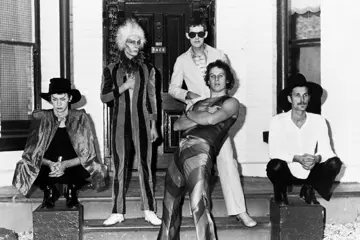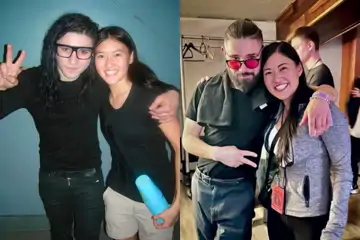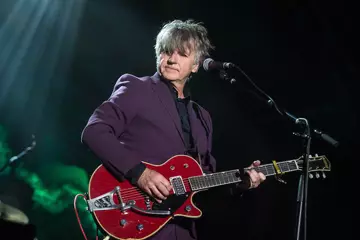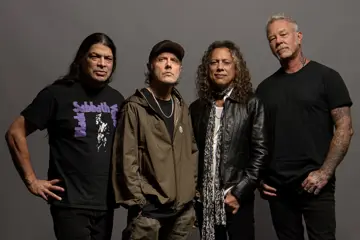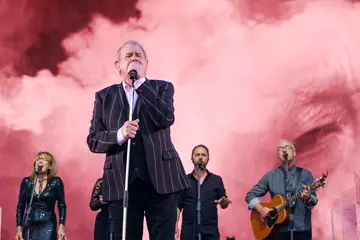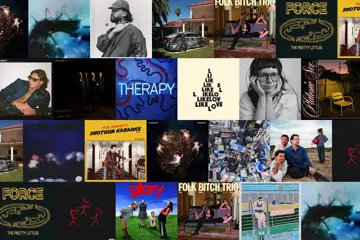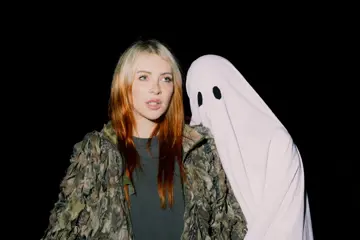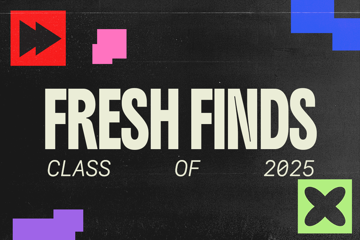LOUIS THEROUX: HEROIN TOWN

When Louis Theroux turns his quizzical gaze on a subject, what’s reflected back is usually comedy. In Heroin Town, it’s tragedy. Here, Theroux wanders into Huntington, West Virginia, where the entire population of 50,000 people is caught up in a downward drug spiral. If they’re not users, injecting the readily-available and financially-accessible titular substance, then they’re the paramedics forever reviving the city’s statistically-staggering parade of overdoses, the treatment facility workers trying to help the fallen get clean, or the family members who watch helplessly as their loved-ones steal from them, lie to them, and become shells of their former selves.
It’s the flipside to the American dream; a dystopian nightmare playing out in a small Midwestern town. Theroux looks at the landscape with an outsider’s view, walks blithely into squats and tent-cities and rundown houses, wondering how something so fucked-up could be allowed to happen in a country so wealthy. As a polite, bespectacled Englishman-abroad, his otherness — and his accent — disarm those he comes across. So, too, does the camera. If there’s a meta-text, here, it’s the same that played out in the last Louis lark to hit local cinema screens, My Scientology Movie: the power of the camera.
Here, Theroux and crew point their cameras at the hidden horrors of America; an opiate scourge unknown to the rest of the world, often undocumented. When they arrive on the scene, they are not shunned or exiled, but welcomed in. The figures herein — be they ashamed or proud of their life-obliterating habit — want to tell their stories. Being on screen validates their lives, and their suffering; it brings to light a dark stain on society.
When asking questions, Theroux often reasserts that he doesn’t want to judge the people he’s prodding to respond. These tragic figures, in this little Heroin Town, are tiny players in a far bigger picture. Last time around, the institution of Scientology was a lingering, omnipotent villain; here, this time, it’s the unseen monolith of America’s pharmaceutical giants. When prescription painkillers are handed out like candy, then abruptly cut off, this is the horrifying side-effect: a nation of opiate addicts desperately seeking a fix, in whatever form they can get it.
KILLING OF A SACRED DEER

When Barry Keoghan spits out his evil edict, it comes tumbling out super-fast, comic and absurd. His dad, years before, died in open-heart surgery presided over by Colin Farrell’s cardiologist Steven Murphy; so, now, the ledger must be evened. Farrell has to kill one of his family — wife Nicole Kidman, kids Raffey Cassidy and Sunny Suljic — or they’ll all die. First will come the paralysis of limbs; second, the refusal to eat; third, they’ll bleed from their eyes; and, finally, death.
Despite the fact that Keoghan has undertaken some low-level stalking, attempted to get Farrell to fuck his mum (Alicia Silverstone!), seduced Cassidy via Chang-Chen-and-Shu-Qi-in-Three-Times-esque motorbike rides, and generally scans as ultra unhinged, it’s hard to take the prophesies of a teenage weenie too seriously. Until you remember you’re in a film by Yorgos Lanthimos, the superstar graduate of the Greek weird-wave; who, with co-writer Efthymis Filippou, comes up with oddball premises, and then fashions them into complete — and completely disturbing — cinematic worlds.
And, thus, Killing Of A Sacred Deer is a psychological-thriller told in Lanthimos’s trademark deadpan, and shot through with the horror of Greek myth (its title refers to the tale of Agamemnon and Iphigenia). Once Keoghan’s avenging devil has issued his proclamation, there is no going back: no medical treatment can save the kids, no pleas from Kidman can assuage what-will-be, no offers from Farrell to do some mum-fucking or threats to kill the messenger can sate the wrath of fate. It’s the moral quandary of mythos made an uncomfortable reality, primitivism entering a world of suburban privilege. The deadpan delivery flattens emotions, thus making it a film where the horrors of an impossible choice are made a cold, rational decision; ridiculous set-up given logical rendering, and taken to logical (near-Hanekean) end-point.
It’s, in many ways, a bleak, brutal film; but, Lanthimos and Filippou haven’t lost their irreverence. Kidman and Farrell role-play a sex game called “General Anaesthetic”, where she lies lifeless on their bed, ready to be manhandled by her doctor. Cassidy sings a wonky, a cappella take on Ellie Goulding’s Burn, nervous and half-tuneless, awkwardness building all the while. Keoghan is at the centre of the most memorable scene of disturbing spaghetti-eating since Gummo.
“I don’t know if what’s happening is fair, it’s just the only thing I can think of that’s close to justice,” he pronounces, blithely, tomato sauce speckling his teenaged face. It’s the closest that Lanthimos and Filippou come to tipping their hand: All-American cinematic staples like justice and vengeance explored, here, with grim determination, intellectual rigour, and just the right spirit of ridiculousness.
DETROIT

Kathryn Bigelow’s timely take on the 1967 riots in Detroit opens with a surprising flourish: a history of slavery, segregation, white flight, and police brutality told in animated illustrations evoking African art; folkloric lines dancing in something resembling the rabbit-mythos beginnings of the 1978 disturbing-kids-for-decades adaptation of Watership Down.
It’s a beginning that takes an improbably-long view, with an evolutionary-sociologist’s eye for how events — like a battle in the streets between white police and black protestors — are products of social structures on the grandest scale. From this distant perspective, Bigelow then takes an intermediate step into Detroit’s drama: the next ten minutes splicing archival news footage with riot re-enactments; the milieu aping documentary’s reactionary camera. There’s no real characterisation or dialogue, yet, no turning of history into human-narrative. It’s an exercise in grounding that builds a foundation, for a story that, soon thereafter, will take place in a single location house.
It’s a motel, where a host of transient locals have holed up for the night; be it to party, get it on, or escape from the dangers of the riot-torn streets. The motel soon becomes a prison, when a trio of white cops (Will Poulter, Jack Reynor, Ben O’Toole) round up our largely-African American youths, point guns at them, and undertake a concerted campaign to ‘break’ their detainees; via violence, bullying, and cruel psychological conditioning.
Bigelow’s last film, 2012’s Zero Dark Thirty, put All-American torture front-and-centre; and, in many ways, Detroit does the same. It features classic figures of authority — not just cops, but white American males — turning the screws on luckless captors; not in search of truth or justice, but only what can expedite their own needs, confirm their own prejudices. Despite John Boyega being penned as an everyman middle-man — an African American security guard, he’s a midpoint between the police and the ‘suspects’ — there’s little complexity to the story. Instead, it makes an audience witness to the horrors of real history; viewers held captive, too, by a narrative that refuses to look away. It’s a cry of outrage at the injustices of the past, that pulls clear double-duty as indictment of the present.
PROFESSOR MARSTON AND THE WONDER WOMEN

If origin stories are the favoured currency of the superhero movie, it makes sense that the origin story of the creation of that superhero is fitting drama for a film. Especially when the based-on-a-true-story tale behind that superhero is as dramatic as the story behind the invention of Wonder Woman. Here, we meet Luke Evans’ titular author, in a framing narrative in which he’s giving testimony against accusations his comic books are full of “sex perversions”, unholy and amoral and out-of-step with the family-values of 1947. As testimony begets otherwise-chronologically-told tours through the past, what unfolds feels rather like a companion to television’s Masters Of Sex: in which scientifically-minded, sex-positive progressives must constantly battle against the wowsers of the day.
Two decades prior, Evans is a psychology professor in a natty array of three-piece tweed suits. His wife, Rebecca Hall (who is really great, herein), is also a psychology professor, and introduced as independent-woman: wearer of short hair and wide pants; user of words like “fuck” and “vagina” aloud; non-believer in sexual jealousy; agitator for gender equality. They meet Bella Heathcote’s cutesy, curious student assistant, and, not long after the trio’ve visited a speakeasy — and discovered Heathcote was descended from suffragettes, her blood that of the American feminist movement — the three of them are getting fresh in a Roaring-’20s ménage-à-trois; fucking, for the inhibition-shattering first time, to the anachronistic sounds of Nina Simone’s Feeling Good.
What unfolds melds different ideas into one slick, behatted, prestige-pic type package: an exploration of the dom/sub psychology at play in early Wonder Woman; a softly-lensed sex flick, in which one man has a blonde on one arm and a brunette on the other; an in-the-closet drama, whereby a secret-life is always under threat of being found out by an unforgiving society; and an exercise in now-we-know-better moralising, where essentially modern characters are trapped in the backwards morality of an archaic society.
There’s a nobility to its mission, but writer/director Angela Robinson is also a slave to convention: when one period-piece character coughs, you know they’re going to die soon thereafter; and the only time it rains is in the down-moment just before the public-declaration-of-love finale. She also has a tendency to literalise themes: Evans doesn’t just speak the themes aloud in his testimonial hearing, there are moments where he actually just writes them in chalk on blackboard.
BORG VS MCENROE

Mere weeks after the Marriage Equality debate was played out on the court, in Battle Of The Sexes, here’s another tennis tale in vintage ’70s threads. Befitting its title, it’s a two-hander, pirouetting through backstory and history as its titular men trade serves, rallies, and narrative lead. There’s no greater symbolism to their battle, nor much meaning in the film beyond ‘portrait of sportspeople’.
These sportspeople were stereotyped as polar opposites: emotionless Swede vs overly-emotional American; the taciturn, monastic, robotic Iceborg the antithesis to the Superbrat’s verbose, pissed-off, angst-riddled New Yorker. At first, screenwriter Ronnie Sandahl and director Janus Metz Pederson play up to that idea: early stretches involving Borg are told in silence, McEnroe’s halves filled with rock’n’roll and Ramones t-shirts. But as the tennis tournament — 1980 Wimbledon — plays on, and we retreat into various scattershot visions of the past, those simplistic renderings are scratched at. And these rivals reach a place where the person that best understands them is the other. As a Bond villain is prone to soliloquise: we’re not so different, you and I.
The co-billing of the foes shows Sandahl’s intention to make a film with twin protagonists; where neither is hero or villain. Its model appears to be 2013’s Rush, about the Formula One battles between Niki Lauda and James Hunt; though that comparison brings up the absence of anything approximating the Anthony Dod Mantle-DOP’d mania of certain sequences therein. Pederson cut his teeth as documentarian, and he brings an unobtrusive observationism to a film that never really pokes at its characters, provokes the audience. Shia LaBeouf is born to play McEnroe, and Sverrir Gudnason looks suitably Borg-y, but each feels distant; tennis obsessives whose internal wiring is hard to depict, and dramatise. At least their wigs look good; Tom Datnow takes the court as Jimmy Connors in a wig so bad it brings the film to a temporary halt, earning a place in cinema’s Bad Wig Hall Of Shame.
LUCKY

What a cinematic send-off. In his final film, 90-year-old Harry Dean Stanton is the titular character in Lucky, a curmudgeonly cowboy in some cowpoke town in the dusty deserts of the West. He drinks, he smokes, he challenges attorneys to fights. His doctor has no idea how he’s still alive. His quotidian routine is unchanging, a little obsessive: every day he goes to the same diner and the same bar, does the same crossword, watches the same gameshows. His life is largely empty, but filled with a collection of memorable oddballs, played by people like old pal David Lynch, Barry Shabaka Henley, Ed Begley Jr, Beth Grant, Tom Skerritt, and Ron Livingston. The film is notably directed by John Carroll Lynch, one of the most memorable character actors of this century, meaning its filmmaker knows the drama and desires of odd, memorable figures, even when they flit through frame.
At times, there’s moments that the screenplay — by Logan Sparks and Drago Sumonja — can get a little cute; as when Stanton reads out the dictionary definition of ‘realism’. But, mostly, it remains so slight as to be almost zen-like; feeling as stripped-down and meditative as a Jim Jarmusch film, save the stylisation. In one of Lucky’s ‘showier’ moments (relatively speaking), Stanton is shown sucking deep on a nocturnal cigarette whilst Johnny Cash’s cover of Will Oldham’s I See A Darkness plays out loud. It’s a recording from Cash’s late period, where every song felt as if he was staring mortality in its face. So, too, is there a sense that Stanton, in every line of Lucky, is confronting his own mortality. “I’m scared,” he confesses, fear etched into every line on his face; on screen and in life, an atheist staring headlong into oblivion. He died, at 91, in September, giving Lucky an extra shot of resonance. It may be slight, but it’s sure poignant.


